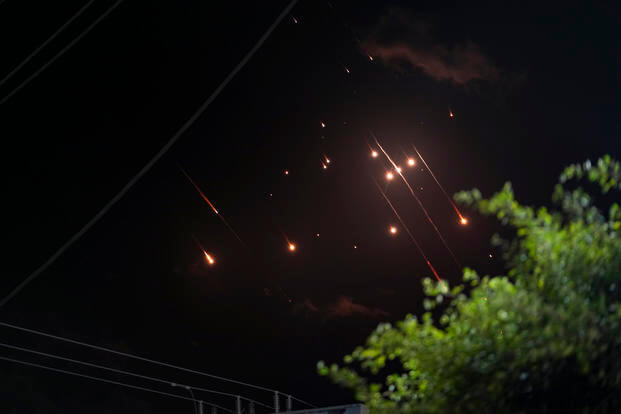Two U.S. Navy destroyers helped defend Israel against a ballistic missile attack by Iran on Tuesday that threatened to plunge the region into a wider conflict, U.S. officials confirmed.
The USS Bulkeley and USS Cole fired “approximately a dozen interceptors against the incoming Iranian missiles,” which were captured on video streaking across the night sky above Israel, according to Pentagon press secretary Maj. Gen. Pat Ryder, who publicly briefed reporters.
The two ships were part of the effort to thwart an attack that officials described as nearly twice the size of Iran’s earlier missile barrage on Israel in April. White House National Security Adviser Jake Sullivan said the result was that the latest attack was effectively defeated, describing it as “ineffective” at a briefing Tuesday.
Read Next: Georgia Army Base Struggling with Power, Potable Water After Hurricane Helene
Over the weekend, Defense Secretary Lloyd Austin ordered several thousand more U.S. troops to the Middle East amid growing turmoil. The additional forces include F-16, F-15E, A-10, F-22 fighter aircraft and their associated personnel.
The missile barrage was the latest in the escalating violence, which began last October with a brutal surprise attack by Hamas against Israeli civilians. That led Israel to launch a full-scale military operation to root out Hamas and rescue hostages in Gaza that has grinded on for months.
On Monday, Israel launched a ground operation into neighboring Lebanon after a series of recent strikes against Hezbollah, an Iranian proxy in the region, which killed its top leader, Hassan Nasrallah. Those military operations appeared to have sparked the Iranian missile attack.
The Iranian UN mission said that the barrage of around 200 ballistic missiles on Tuesday was “Iran’s legal, rational and legitimate response to the terrorist acts … which involved targeting Iranian nationals and interests and infringing upon the national sovereignty of the Islamic Republic of Iran.”
There was no immediate reports of casualties from the attack on Tuesday, according to The Associated Press.
“You don’t launch that many missiles at a target without the intent of doing something so, absolutely, just like the last time, their intent is to cause destruction,” Ryder said.
Ryder stressed that no American personnel were harmed in the attack, but he wasn’t able to offer many more details about the scale of the U.S. participation, including whether any of the 12 interceptors actually struck any incoming missiles.
“We’re still assessing … outcomes of that so … I just don’t have more information,” he said.
Ryder also refused to get into details about what kind of missiles the pair of destroyers fired.
As tensions in the region continue to escalate, both Ryder and Sullivan wouldn’t say whether there was planning for the 24th Marine Expeditionary Unit currently deployed with the USS Wasp Amphibious Readiness Group to evacuate U.S. citizens either from Lebanon or Israel.
“Right now, there has been no order to evacuate,” Ryder said before adding that “of course, we plan for all contingencies.”
In addition to a trio of destroyers and the USS Wasp group in the eastern Mediterranean, the U.S. Navy has some ships in the Red Sea, and the USS Abraham Lincoln and a destroyer in the Gulf of Oman.
Related: Thousands More US Troops, Attack Aircraft Heading to Middle East as Israel Targets Hezbollah in Lebanon
Story Continues
Read the full article here

